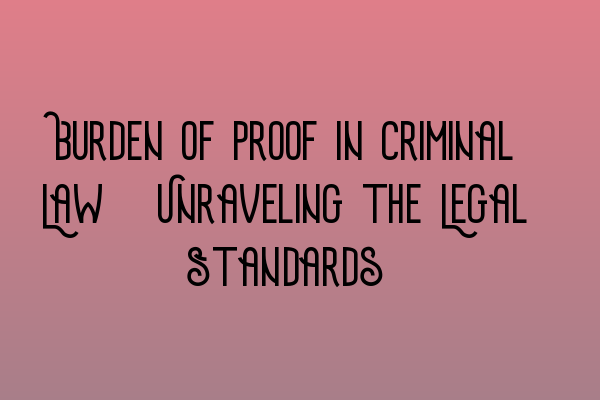The Burden of Proof in Criminal Law: Unraveling the Legal Standards
Welcome to the SQE Criminal Law & Practice Law Blog, where we explore various aspects of criminal law and provide valuable insights to legal professionals and law students alike. In this blog post, we will delve into the concept of the burden of proof in criminal law and demystify the legal standards surrounding it.
What is the Burden of Proof? Why is it Important?
The burden of proof is a fundamental principle in criminal law that places the responsibility on the prosecution to prove beyond a reasonable doubt that the accused is guilty. This means that the prosecution must present sufficient evidence to convince the court or jury that the accused committed the alleged crime.
This principle is important because it safeguards the rights of the accused and upholds the presumption of innocence until proven guilty. It places the onus on the state to establish guilt, rather than requiring the accused to prove their innocence.
Understanding the burden of proof is crucial for legal professionals, as it affects the way cases are prepared, presented, and defended. It is essential to grasp the legal standards associated with the burden of proof to effectively represent clients in criminal proceedings.
Legal Standards in Criminal Law
In criminal law, there are different legal standards that determine the burden of proof at different stages of the legal process. Let’s take a closer look at these standards:
- Beyond a Reasonable Doubt: This is the highest standard of proof in criminal law. It requires the prosecution to establish guilt to the extent that there is no reasonable doubt in the minds of the jurors or judge about the accused’s guilt.
- Clear and Convincing Evidence: This standard falls between the beyond a reasonable doubt standard and the preponderance of the evidence standard. It requires the prosecution to present evidence that is highly and substantially more likely to be true than not, leaving little doubt in the minds of the fact-finders.
- Preponderance of the Evidence: This standard is commonly employed in civil cases and requires the prosecution to prove that it is more likely than not (greater than 50%) that the accused committed the alleged crime.
Implications for Criminal Law Practice
The burden of proof and the associated legal standards have significant implications for criminal law practice. Legal professionals must thoroughly assess the evidence presented by the prosecution and develop a strong defense strategy based on the applicable burden of proof.
Our SQE Criminal Law & Practice Law UK courses provide comprehensive training on the burden of proof and other key aspects of criminal law. Whether you’re preparing for the SQE 1 or SQE 2 exams, we offer practice exam questions, mock exams, and preparation courses to help you enhance your knowledge and skills. Make sure to check out our SQE 1 Practice Exam Questions and SQE 1 Practice Mocks FLK1 FLK2 articles for additional resources.
In addition, our SQE 2 Preparation Courses and SQE 1 Preparation Courses are designed to equip you with the necessary skills to excel in your legal career. Stay updated with the latest SRA SQE Exam Dates to plan your preparation effectively.
By mastering the concepts surrounding the burden of proof and staying up-to-date with the latest legal standards, you can enhance your ability to represent clients effectively and navigate the complex landscape of criminal law.
For more insights and expert guidance on criminal law and practice, stay tuned to our blog for future articles. If you have any questions or would like to discuss your legal career aspirations, don’t hesitate to get in touch with our team of experienced professionals.
Disclaimer: The information provided in this blog post is for educational purposes only and should not be considered as legal advice. Consult with a qualified solicitor for specific legal guidance.
